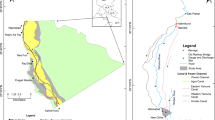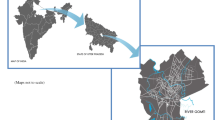Abstract
Subansiri–Ranganadi Doab (confluence country), located in Lakhimpur district, Assam, is one of the worst flood-affected areas in Brahmaputra valley. The Doab is well populated, and land around these rivers is extensively used for cultivation. As means of flood protection, embankments were constructed in the 1950s along the banks of both the rivers. On the other hand, these rivers are dynamic in terms of banklines and other forms of channel changes. Progressive migration of bankline, due to erosion, results in loss of cultivable land. Moreover, it causes breaches in the embankments increasing the severity of flood in the Doab. This paper attempts to study the changes in the banklines of two major rivers in the floodplains of the Subansiri–Ranganadi Doab during 1997–2009 in the context of the riverine hazards it brings to the floodplain dwellers. The shift of the banklines in Subansiri–Ranganadi Doab, downstream of North Lakhimpur, has been estimated using IRS LISS imageries of 1997 and 2009 in GIS environment. The river Subansiri during the study period has migrated westward and has widened substantially resulting in erosion of an area of ~19.137 km2. For Ranganadi, the total area that has been eroded due to channel changes is ~0.897 km2. The channel changes are mainly due to concave bank erosion associated with high stages of flow. Channel widening in Subansiri and Ranganadi in the study area during the decades of 1990s and 2000 has led to frequent breaches in the embankments. Lateral erosion and inundation due to embankment failure are the most dominant facets of riverine hazards in the study area as these lead to loss of livelihood. Therefore, it is necessary to incorporate geomorphic changes in formulating flood management programmes.








Similar content being viewed by others
References
Annual reports on the flood situation of Brahmaputra and Barak valley, 1990-2008, Flood control department, Government of Assam
Dutta MK, Barman S, Aggarwal SP (2010) A study of erosion-deposition processes around Majuli Island, Assam. Earth Science India (open access e-journal) 3:206–216. http://www.earthscienceindia.info/;eISSN:0974-8350
Fuller IC, Large ARG, Milan DJ (2003) Quantifying channel development and sediment transfer following chute cutoff in a wandering gravel-bed river. Geomorphology 54:307–323
Gaurav K, Sinha R, Panda PK (2011) The Indus flood of 2010 in Pakistan: a perspective analysis using remote sensing data. Nat Hazards. doi 10.1007/s11069-011-9869-6
Ghoshal S, James AL, Singer MB, Aalto R (2010) Channel and floodplain change analysis over a 100-year period: lower Yuba river, California. Remote Sens doi:10.3390/rs2071797
Gilvear DJ, Black AR (1999) Flood- induced embankment failures on the river Tay: implications of climatically induced hydrological change in Scotland. Hydrol Sci 44:345–362
Goswami U, Sarma JN, Patgiri AD (1999) River channel changes of the Subansiri in Assam, India. Geomorphology 30:227–244
Hutton D, Haque CE (2003) Patterns of coping and adaptation among erosion-induced displacees in Bangladesh: implications for hazard analysis and mitigation. Nat Hazards 29:405–421
Hutton D, Haque CE (2004) Human vulnerability, dislocation and resettlement: adaptation process of river-bank erosion-induced displaces in Bangladesh. Disasters 28:41–62
Kotoky P, Bezbaruah D, Baruah J, Sarma JN (2005) Nature of bank erosion along the Brahmaputra river channel, Assam, India. Curr Sci 88:634–639
Kummu M, Lu XX, Rasphone A, Sarkkula J, Koponen J (2008) Riverbank changes along the Mekong River: remote sensing detection in the Vientiane-Nong Khai area. Quat Int 186:100–112
Li L, Lu XX, Chen Z (2007) River channel change during the last 50 years in the middle Yangtze River, the Jianli reach. Geomorphology 85:185–196
Mani P, Kumar R, Chatterjee C (2003) Erosion study of a part of Majuli river-island Using remote sensing data. J Indian Soc Remote Sens 31:11–18
Ollero A (2010) Channel changes and floodplain management in meandering middle Ebro river, Spain. Geomorphology 117:247–260
Rinaldi M (2003) Recent channel adjustments in alluvial rivers of Tuscany, Central Italy. Earth Surf Process Landf 28:587–608
Sarma JN, Borah D, Goswami U (2007) Change of river channel and bank erosion of the Burhi Dihing river (Assam), assessed using remote sensing data and GIS. J Indian Soc Remote Sens 35:93–100
Schumm SA (1968) River adjustment to altered hydrologic regiment- Murrumbidgee river and paleochannels, Australia. US Geol Surv Prof Paper 598:65
Schumm SA, Lichty RW (1963) Channel widening and floodplain construction along Cimarron river in southwestern Kansas. US Geol Surv Prof Paper 352-D:71–88
Singh DS, Awasthi A (2011) Natural hazards in Ghaghara river area, Ganga plain, India. Nat Hazards 57:213–225
Sinha R (2009) The great avulsion of Kosi on 18 August 2008. Curr Sci 97:429–433
Surian N (1999) Channel changes due to river regulation: the case of Piave river, Italy. Earth Surf Process Landf 24:1135–1151
Surian N, Rinaldi M (2003) Morphological response to river engineering and management in alluvial channels in Italy. Geomorphology 50:307–326
Thakur PK, Laha C, Aggarwal SP (2011) River bank erosion hazard study of river Ganga, upstream of Farakka barrage using remote sensing and GIS. Nat Hazards. doi:10.1007/s11069-011-9944-z
Winterbottom SJ (2000) Medium and short-term channel planform changes on the Rivers Tay and Tummel, Scotland. Geomorphology 34:195–208
Xu J (1997) Evolution of mid-channel bars in braided river and complex response to reservoir construction: an example from the middle Hanjiang River, china. Earth Surf Process Landf 22:953–965
Yang SL, Zhao QY, Belkin IM (2002) Temporal variation in the sediment load of the Yangtze river and the influences of human activities. J Hydrol 263:56–71
Acknowledgments
Authors are thankful to Prof. D C Baruah, Principal Investigator DST-Sponsored project “Agro-Climatic Zone Based Mapping of Renewable Energy Resources in Assam”, for providing certain data used in this study. Authors are also thankful to Mr. M. Hiloidhari, Project Fellow, for his help in analysis.
Author information
Authors and Affiliations
Corresponding author
Rights and permissions
About this article
Cite this article
Das, A.K., Sah, R.K. & Hazarika, N. Bankline change and the facets of riverine hazards in the floodplain of Subansiri–Ranganadi Doab, Brahmaputra Valley, India. Nat Hazards 64, 1015–1028 (2012). https://doi.org/10.1007/s11069-012-0283-5
Received:
Accepted:
Published:
Issue Date:
DOI: https://doi.org/10.1007/s11069-012-0283-5




